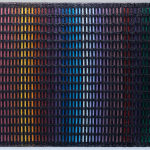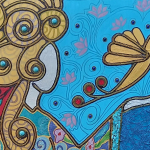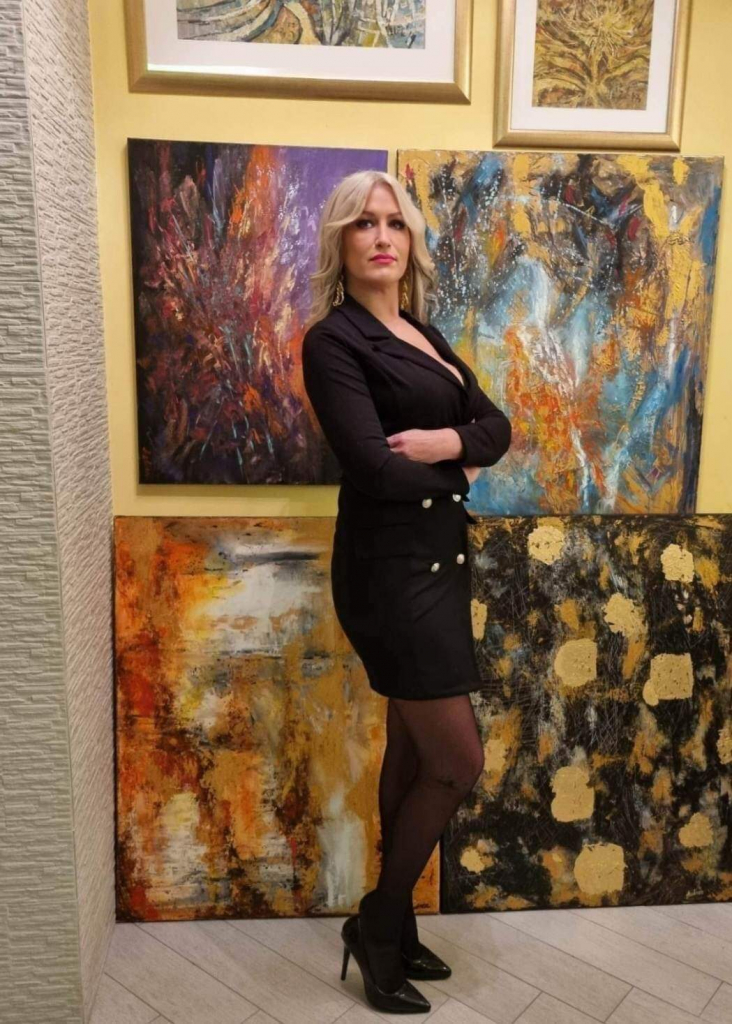
Croata residente a Fiume, città di mare da cui può quotidianamente osservare quei panorami affascinanti da cui trae ispirazione per le sue opere, sceglie però di non adottare uno stile figurativo che le permetterebbe di rappresentare i paesaggi a metà tra mari e monti, bensì preferisce interpretare tutte quelle sensazioni intense che di fronte a tanta bellezza emergono andando a toccare corde interiori che spesso rimangono senza voce. In virtù di questo intento creativo predilige quindi l’Espressionismo Astratto che le permette non solo di indagare tutte le pieghe e i risvolti dell’anima ma anche di trasformare i colori in vero e proprio linguaggio da adeguare al sentire del momento in cui si pone davanti alla tela. La dimensione che più le permette di liberare la sua interiorità è quella del sogno, dell’immaginario, di quel mondo sospeso dove la realtà osservata costituisce solo uno spunto per permettere alla mente di distaccarsi dalla logica e andare verso il regno del possibile, del percepibile concedendo a lei per prima, e di conseguenza all’osservatore, di farsi trascinare dall’irrazionalità troppo spesso vista con accezione negativa, dimenticando che è proprio grazie a essa che è possibile intravedere tutto ciò che appare invisibile. Andrea Stanic con le sue tele conduce il fruitore verso quel regno incantato eppure incredibilmente lucido e in grado di andare oltre, di spostare la cortina di apparenza che copre il quotidiano e spingersi verso le emozioni che abitualmente vengono trattenute per il timore dell’individuo di sentirsi scoperto e fragili; tuttavia senza di esse, suggerisce l’artista, non è possibile vivere un’esistenza piena e felice, è solo dopo un’approfondita analisi di sé e persino delle proprie debolezze interiori, che si può trovare consapevolezza della forza necessaria a continuare a essere se stessi pur proteggendo le morbidezze che vanno tutelate. Dunque abbattere le barriere della razionalità, che nell’arte corrispondono all’attinenza all’osservato quotidiano, è il modo attraverso cui conoscere il proprio io interiore; la forma astratta e indefinita è il mezzo per raggiungere questo importante obiettivo perché osservando un’opera che non dà regole visive, non fornisce immagini e significati specifici bensì concede l’apertura interpretativa per dare il proprio senso a ciò dentro cui lo sguardo si perde, allora la mente è costretta ad abbassare le sue difese e senza più regole cerca una connessione con l’unica guida in grado di permetterle di comprendere l’incomprensibile, cioè l’anima. L’opera Infinite Happiness
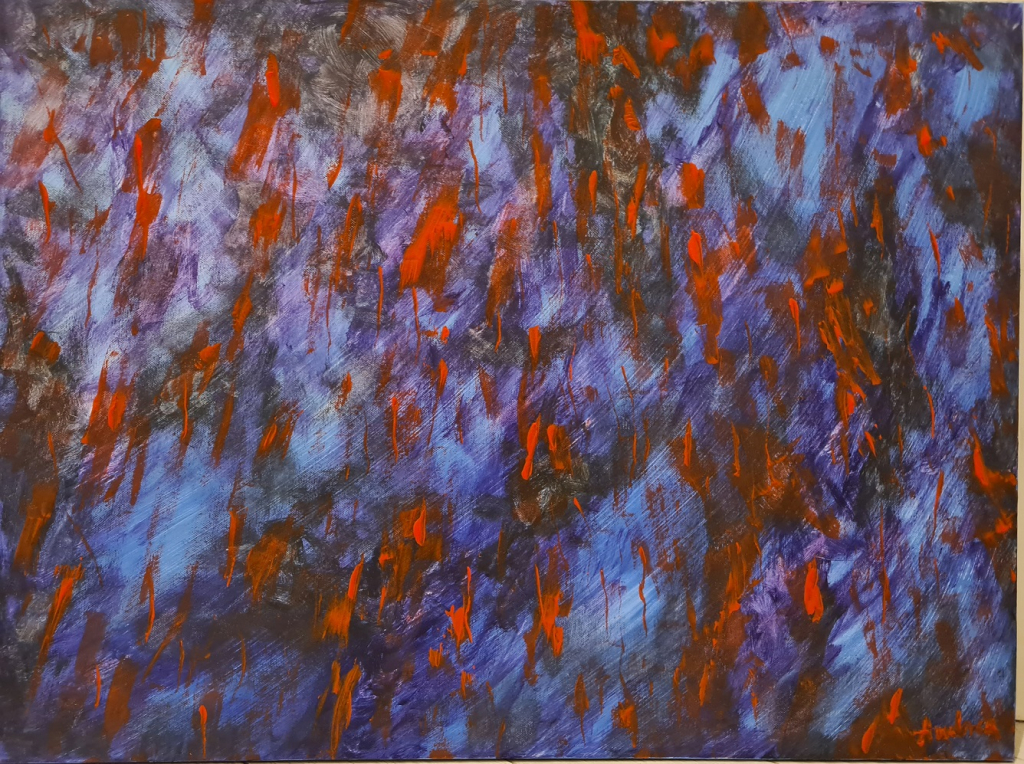
è il simbolo del punto di vista artistico di Andrea Stanic, infatti la tela è letteralmente invasa da quelle virgole di gioia e di piacevolezza che sembrano saltellare sopra lo sfondo in toni di viola, che è associato all’anima e all’interiorità; la sensazione per chi guarda è travolgente, trascinante, un invito a sorridere alla vita e a tutto ciò che offre perché in fondo la felicità è tutta una questione di approccio all’esistenza, ogni circostanza può essere osservata in modo negativo oppure in modo positivo, ed è questa, suggerisce l’artista, la scelta migliore e più appagante. Fairytale Sunset

ha un approccio espressivo differente, le pennellate si fanno dense, piene, quasi a sottolineare quanto la fiaba di cui l’artista parla nel titolo, possa trasformarsi in qualcosa di reale se solo si crede in lei; le tonalità cromatiche sono irreali, giocate tra il beige che rappresenta la serenità del cielo, il nero che sembra suggerire la presenza di una città, il viola che sopraggiunge a dare quel tocco incantato all’immagine e infine gli arancioni, specchio del sole sull’acqua del mare della Croazia. Qui l’Espressionismo Astratto è più contemplativo che impulsivo, sembra essere frutto di una meditazione, di un soffermarsi sull’idea della bellezza di poter, anche solo per un attimo, riuscire a vivere in una favola, quella in cui persino la natura decide di armonizzarsi a quel sogno interiore accarezzato e concretizzato attraverso la pittura. Andrea Stanic ha lo stesso carattere aperto e socievole che emerge dalle sue opere e che l’ha portata a costruire legami importanti con organizzazioni e associazioni internazionali di cui è diventata non solo rappresentante ma anche ambasciatrice. Andiamo ora ad approfondire la conoscenza con l’artista.
Andrea, lei vive in una città divisa tra mari e monti, vicinissima all’Italia e quasi al confine con la Slovenia: quanto ha influito questa vicinanza con due nazioni così diverse nella sua formazione artistica? Crede che la sua apertura al possibilismo e al sogno derivi dalla possibilità di confrontarsi con culture differenti oppure piuttosto dal fatto di vivere in una città di mare?
La mia città Rijeka, la mia Opatija, e la natura della mia regione sono la mia ispirazione, sia che dipinga regate, motivi marini o astrazioni. Nella sua storia, la città di Fiume è stata attraversata da diversi stati e culture, e questo è visibile nella sua architettura. Allo stesso modo, quella città, come me, è sempre stata una città di diversità, pronta ad accettare diverse nuove influenze. Dipingo da venti anni e ho un gran numero di mostre individuali e collettive, sia fisiche che virtuali, le quali hanno avuto grande impatto sul mio sviluppo professionale, soprattutto dopo che mia figlia ha iniziato l’università perché ho avuto più tempo per dedicarmi alla pittura, dunque ho potuto entrare in contatto con moltissimi artisti e questo ha contribuito ancor più ad aprire la mia mente e il mio atteggiamento, già decisamente possibilista in virtù del mio essere nata a Fiume. Inoltre il periodo del lockdown mi ha portata a essere più attiva sui social network, così sono entrata in contatto con molti artisti di tutto il mondo, partecipando a mostre virtuali, quasi le uniche a cui era possibile aderire. Tutto questo ha contribuito a formare e a migliorare il mio approccio stilistico e la mia empatia nei confronti del mondo e delle differenze culturali e caratteriali delle persone.
Lei si lascia ispirare dai paesaggi che la circondano ma poi sceglie di non rappresentarli, preferendo un stile astratto; ci spiega il motivo di questa scelta? In alcune opere emerge anche una leggera figurazione espressionista, sulla base di cosa sceglie quest’altro tipo di approccio? È qualcosa che si concretizza spontaneamente mentre dipinge oppure decide tutto prima di sedersi davanti alla tela?
Mi ispiro ai motivi che mi circondano. Nelle astrazioni, esploro spesso il mondo interiore dei sentimenti che sono spesso nascosti nelle persone. Ultimamente mi sono concentrato di più sulle astrazioni. Perché? Ecco perché a volte è bene cambiare, ti stanchi di uno stile, un artista non è un robot. L’astrazione non annoia mai. L’astrazione risveglia molte emozioni attraverso il colore, la composizione ed è molto ben accolta nell’arte contemporanea e moderna perché si inserisce bene in ogni contesto. Le mie opere incoraggiano l’immaginazione, stimolano le emozioni individuali. Ogni giorno nel dipinto vedi e vivi qualcosa di nuovo, tutto dipende da come ti senti in quel momento. Le persone vogliono immagini astratte nel loro spazio, e io voglio che tutti, dalle persone comuni ai collezionisti agli uffici aziendali, possiedano i miei lavori, indipendentemente dalle dimensioni. Nei miei dipinti si trova la forza, la sensazione di spontaneità, la libertà, la tenerezza, l’ariosità perché mi rendo conto che la maggior parte delle persone ha bisogno di serenità; io stessa conduco una vita frenetica e stressante. Invece attraverso la figurazione mi piace enfatizzare figure umane, sagome di donne, la città, riferimenti appena accennati che sorgono spontaneamente. La spaziosità nella mia pittura dovrebbe essere vista esclusivamente attraverso l’oggetto del desiderio interiore di un individuo. Quando dipingo sono coinvolti molti sensi: vista, olfatto, tatto. Sono sempre senza un piano quando creo, mi arrendo al momento del sentire.
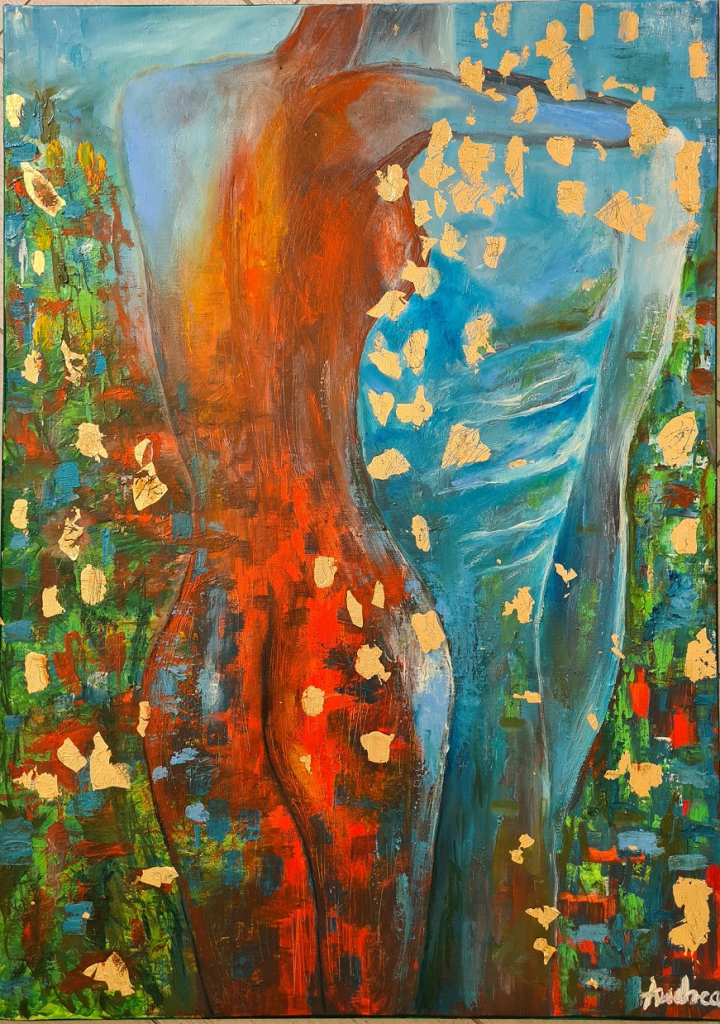
L’Espressionismo Astratto ha avuto grandi rappresentanti sia negli Stati Uniti, dove è nato, sia in Europa. Quali sono i maestri a cui si ispira o a cui si sente più vicina dal punto di vista stilistico? E quali quelli per cui, pur non essendo vicini al suo intento pittorico, prova ammirazione riconoscendone il percorso che hanno segnato nella storia dell’arte?
Sono sempre stata affascinata dai grandi maestri dell’arte moderna contemporanea con le loro pennellate e i loro atteggiamenti, erano ribelli, sfidavano il tempo, l’ambiente, lottavano per essere accettati come artisti e simboli della loro pittura. Tra quelli che ammiro di più ci sono Lee Krasner, Mark Rothko, Jackson Pollock, Michael Wesik, Joan Mitchell, Paul Cézanne. Non erano limitati dallo stile, dall’ambiente in cui vivevano e questo mi piace perché l’arte e la pittura non devono essere comprese, se fossero comprese, non ci sarebbero critiche, né cattive né buone. Quando sei sicuro di te stesso come artista, tutto diventa più facile, penso che il sacrificio umano e il coraggio siano ciò che è importante raggiungere e devi sempre ricordare che devi prima creare un’immagine per te stesso e solo per te stesso. Non provare a dipingere per gli altri intorno a te perché alle persone piace o non piace il tuo lavoro, non c’è una terza via.
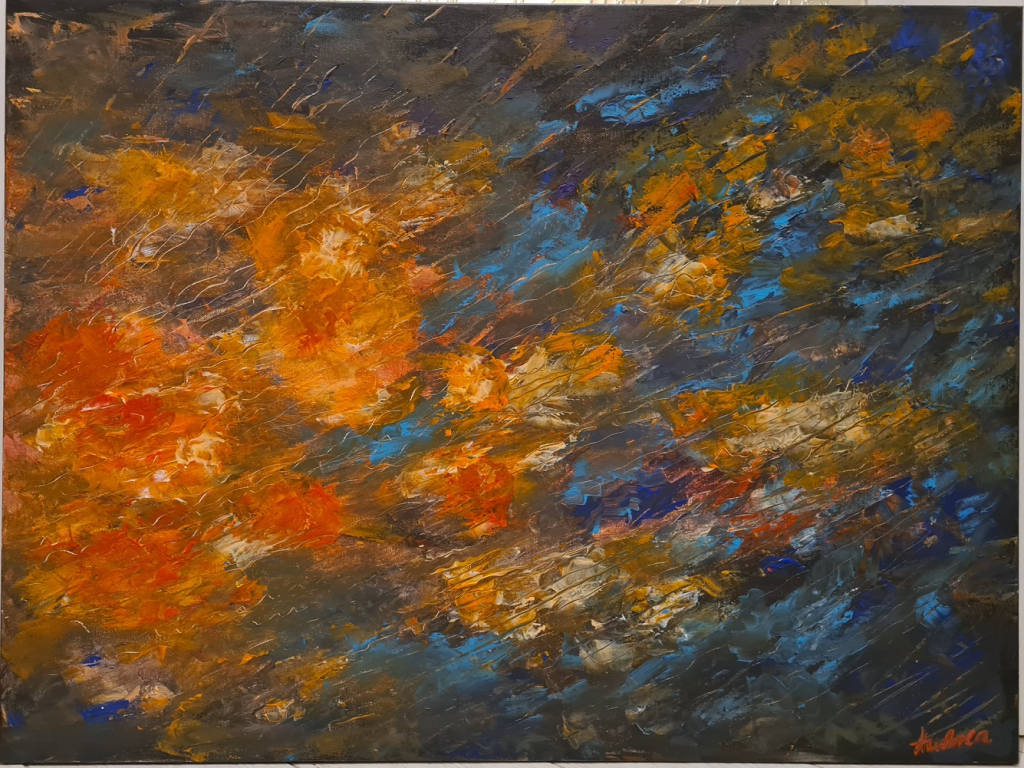
Parliamo ora della sua intensa attività di ambasciatrice e rappresentante di organizzazioni e associazioni riconosciute a livello mondiale. Ci nomina le più importanti e anche le sensazioni che ha provato quando ha ricevuto questi riconoscimenti? Ci vuole parlare anche delle aste di beneficenza a cui ha partecipato?
Ho ricevuto il mio primo importante riconoscimento e diploma per il mio lavoro dall’artista italiano di fama mondiale Enzo Marino di Napoli. C’era anche il suo invito (di Marta Lock) a scrivere una critica d’arte professionale per me e avere un testo da una critica d’arte internazionale mi ha dato un grande coraggio per continuare a candidarmi alle mostre, per inviare i miei lavori. Dopo tanto lavoro, fatica, investimento, perché si sa che anche le quote di iscrizione sono care così come il materiale per dipingere, non mi sono arresa, soprattutto dopo i premi e i riconoscimenti che ho ottenuto alle mostre. È stata una nuova realizzazione delle mie visioni artistiche e ho capito che niente nella vita arriva dall’oggi al domani. Ci vuole molto impegno, investimento, sacrificio. lavoro quotidiano. Con il lavoro che faccio, gli obblighi personali, la mia giornata lavorativa a volte dura 18-20 ore, non sempre ma abbastanza spesso. Sono felice che questo sforzo abbia dato i suoi frutti, che molte persone lo abbiano riconosciuto, che lo apprezzino. Per quanto riguarda la rappresentanza nelle organizzazioni, è difficile individuare il riconoscimento che mi ha gratificata di più perché sono tutti molto importanti per me, apprezzo e rispetto ognuna delle persone che mi hanno premiata. Amo collaborare con artisti di tutto il mondo perché l’arte è un ponte che unisce le persone e siamo tutti sotto la stessa bandiera, la fede. Nel mio paese sono membro dell’Associazione Croata degli Artisti della Croazia con sede a Zagabria, sono membro dell’Associazione Internazionale degli Artisti Professionisti VIPPA-Vision Art Media di New York, sono un ambasciatore in un’organizzazione culturale, artistica e religiosa REALIZA-LA-PAZ in Argentina, IAC BRAND Ambasciatore della Croazia in IAC. Per me è speciale essere un membro riconosciuto e permanente dell’U.N.O.T.A-United Nations Arts CIA, l’organizzazione più direttamente collegata con i consiglieri dell’UNESCO, e che il mio nome artistico sia protetto dalla loro garanzia. Sono vincitore di prestigiosi premi, i miei lavori sono stati pubblicati su riviste d’arte moderna, ho partecipato a biennali d’arte contemporanea, ho ricevuto il 2° premio della biennale al concorso mondiale POP ART, per me ogni premio, così come una mostra, è speciale a modo suo, dalla promozione nei musei alle gallerie, rispetto ogni organizzatore ovunque e li ringrazio tutti per questo. Per quanto riguarda gli eventi di beneficenza, mi piace aiutare nel modo in cui quando si organizza qualcosa, dono un quadro che viene venduto e così il denaro viene pagato direttamente a qualcuno che ha bisogno di aiuto, soprattutto per la salute. “Non dimenticare quante persone mi hanno aiutato allora quando avevo bisogno di aiuto”. C’è una felicità infinita nel fare del bene. È tutta energia positiva che ritorna sempre. Quest’anno sono stata inserita nel libro 50 Artisti su cui investire, a cura di Russo la cui presentazione del volume è stata fatta al Museo della Scienza e della Tecnologia Leonardo da Vinci di Milano. Sono particolarmente felice di essere stata selezionata e di aver partecipato alla mostra internazionale ART INSIDE THE ART SQUARE, che si è svolta in occasione della Giornata mondiale degli artisti a New York, a Times Square, nel cuore di Manhattan, e quell’evento sarà registrato nella storia.
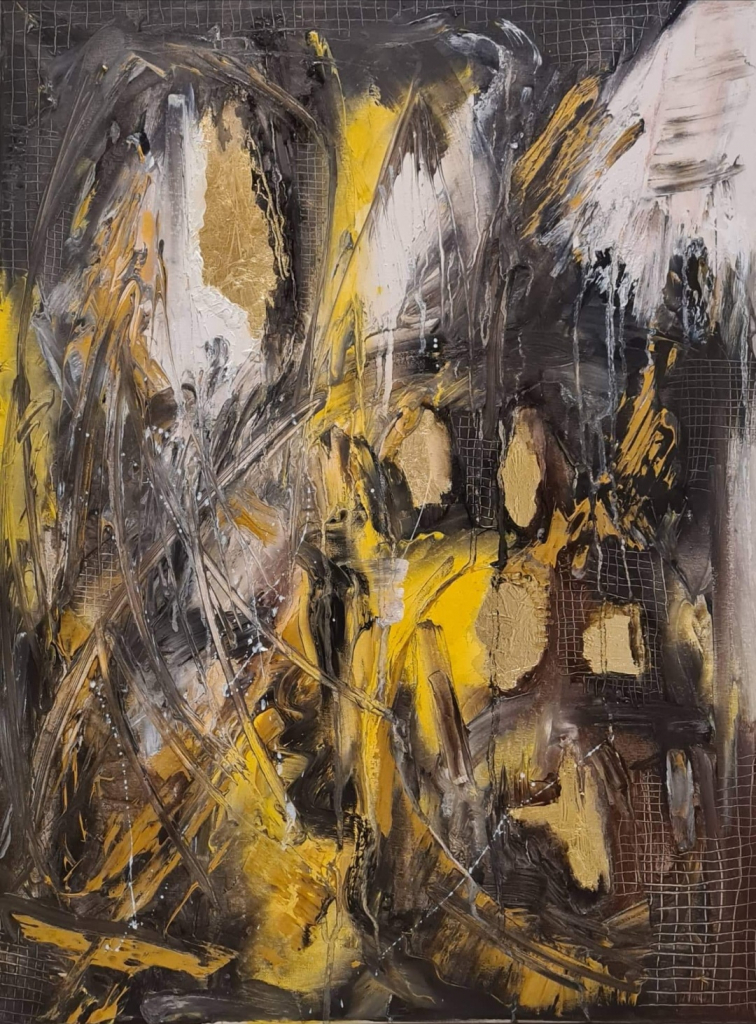
Lei dipinge ormai da venti anni, la sua carriera artistica è costellata della partecipazione a mostre ed eventi in tutto il mondo. Quali sono i suoi prossimi progetti?
Partecipo davvero a mostre in tutto il mondo, dalla Croazia, all’Italia, dove vado di persona, e nel resto del mondo, dove mando le mie opere perché a causa di obblighi e impedimenti personali non riesco a essere presente, anche se spero che questo cambierà. L’anno scorso, io con il mio lavoro e il mio discorso sul tema della pace nel mondo, ho partecipato al VII Geoje Peace Forum e ho ricevuto un riconoscimento speciale dal sindaco e rappresentante parlamentare della città di Goje in Corea del Sud. Una mia opera è stata inclusa nella brochure della Colonna degli artisti d’oltremare, e le immagini sono di proprietà del museo, è il sogno di ogni artista lasciare un segno nel museo. Quest’anno, la direzione del museo organizzerà per me quattro mostre personali, e tra dieci mesi sono stata invitata a ritirare il premio al loro tour di visita e all’Ottavo Festival dell’Arte. Vorrei davvero andarci, vorrei presenziare agli Art Expas che si tengono nel mondo. Sono particolarmente felice che il 20 maggio 2023, nella mia Opatija, in Croazia, avrò una mostra personale dal titolo Living Abstraction che si terrà nell’Art Quarter 2023 – International Art Trimester, sotto gli auspici di UNOTA, UNa, UNICEF. Tra l’altro il 26 maggio ricorre il compleanno di Isadore Ducan, la famosa ballerina americana fondatrice della danza moderna, che nelle sue memorie ha sottolineato che quando soggiornò per la prima volta a Opatija, nel 1902, guardava incantata attraverso le finestre di Villa Amalie e i movimenti dei rami di palma nel vento l’hanno ispirata a rendere il suo stile di danza che l’ha resa unica. Ha anche il suo busto a Opatija, così come un murale, e mi piace pensare che le mie opere siano spontanee come i suoi movimenti. Questi sono i progetti già pianificati ma sono sempre pronta ad accettare nuove proposte perché l’inaspettato è sempre positivo in fondo.
ANDREA STANIC-CONTATTI
Email: andrea.stanic.ri@gmail.com
Sito web: https://andreas-artgallery.eu/hr/
Facebook: https://www.facebook.com/ArtGalleryAndreaS/
Marta Lock’s interviews: Andrea Stanic, abstractions of the mind to explore the realm of the soul
A Croatian woman living in Rijeka, a seaside city from which she can daily observe those fascinating panoramas from which she draws inspiration for her artworks, she chooses, however, not to adopt a figurative style that would allow her to depict landscapes halfway between the sea and the mountains, but prefers to interpret all those intense sensations that emerge in front of so much beauty, touching inner chords that often remain voiceless. By virtue of this creative intent, she therefore prefers Abstract Expressionism, which allows her not only to investigate all the folds and facets of the soul, but also to transform colours into a veritable language to be adapted to the feeling of the moment in front of the canvas. The dimension that most allows her to liberate her interiority is that of the dream, of the imaginary, of that suspended world where observed reality constitutes only a cue to allow the mind to detach itself from logic and go towards the realm of the possible, of the perceivable, allowing her first, and consequently the observer, to be carried away by irrationality, too often seen in a negative light, forgetting that it is thanks to it that it is possible to glimpse all that appears invisible. With his canvases, Andrea Stanic leads the viewer towards that enchanted yet incredibly lucid realm that is able to go beyond, to shift the curtain of appearance that covers the everyday and push towards the emotions that are usually held back due to the individual’s fear of feeling uncovered and fragile; however, without them, the artist suggests, it is not possible to live a full and happy existence; it is only after an in-depth analysis of oneself and even of one’s inner weaknesses that one can find awareness of the strength needed to continue being oneself while protecting the softnesses that must be protected. Therefore, breaking down the barriers of rationality, which in art correspond to relevance to the everyday observed, is the way through which one can get to know one’s inner self; the abstract and indefinite form is the means to achieve this important objective because when observing an artwork that does not give visual rules, does not provide images and specific meanings but rather grants the interpretive openness to give its own meaning to that within which the gaze is lost, then the mind is forced to lower its defences and without any more rules seeks a connection with the only guide capable of allowing it to understand the incomprehensible, that is, the soul. The work Infinite Happiness is the symbol of Andrea Stanic’s artistic point of view, in fact the canvas is literally invaded by those commas of joy and pleasantness that seem to leap above the background in shades of purple, which is associated with the soul and interiority; the sensation for the viewer is overwhelming, enthralling, an invitation to smile at life and all that it offers because after all, happiness is all a matter of approach to existence, every circumstance can be observed negatively or positively, and this, the artist suggests, is the best and most fulfilling choice. Fairytale Sunset has a different expressive approach, the brushstrokes become dense, full, almost as if to emphasise how the fairytale the artist speaks of in the title can be transformed into something real if only one believes in it; the colour tones are unreal, played out between beige representing the serenity of the sky, black that seems to suggest the presence of a city, purple that comes in to give that enchanted touch to the image, and finally the oranges, the mirror of the sun on the water of the Croatian sea. Here, Abstract Expressionism is more contemplative than impulsive, it seems to be the result of meditation, of dwelling on the idea of the beauty of being able, even if only for a moment, to live in a fairytale, one in which even nature decides to harmonise with that inner dream caressed and realised through painting. Andrea Stanic has the same open and sociable character that emerges from her artworks and that has led her to build important ties with international organisations and associations for which she has become not only a representative but also an ambassador. Let us now get to know the artist better.
Andrea, you live in a city divided between the sea and the mountains, very close to Italy and almost on the border with Slovenia: how much has this proximity to two such different nations influenced your artistic training? Do you think that your openness to possibilism and dreams derives from the possibility of confronting different cultures or rather from living in a seaside town?
My city Rijeka, my Opatija, and the nature of my region are my inspiration, whether I paint regattas, marine motifs or abstractions. In its history, the city of Rijeka has been crossed by different states and cultures, and this is visible in its architecture. Likewise, that city, like me, has always been a city of diversity, ready to accept different new influences. I have been painting for twenty years and have a large number of individual and group exhibitions, both physical and virtual, which have had a great impact on my professional development, especially after my daughter started university because I had more time to devote myself to painting , therefore I was able to come into contact with many artists and this contributed even more to open my mind and my attitude, already decidedly optimistic by virtue of my being born in Rijeka. Furthermore, the lockdown period led me to be more active on social networks, so I came into contact with many artists from all over the world, participating in virtual exhibitions, almost the only ones that it was possible to join. All this has contributed to forming and improving my stylistic approach and my empathy towards the world and the cultural and character differences of people.
You are inspired by the landscapes around you but then choose not to represent them, preferring an abstract style; can you explain the reason for this choice? In some paintings, a slight expressionist figuration also emerges, on the basis of what do you choose this other approach? Is it something that materialises spontaneously while you are painting or do you decide everything before you sit in front of the canvas?
I draw inspiration from the motifs that surround me. In abstractions, I explore the inner world of feelings that are often hidden in people. Lately I’ve been focusing more on abstractions. Why? That’s because sometimes it’s good to change, you get tired of a style, an artist is not a robot. Abstraction never bores. Abstraction awakens many emotions through color, composition and is very well received in contemporary and modern art because it fits well in any context. My artworks encourage imagination, stimulate individual emotions. Every day in the painting you see and experience something new, it all depends on how you feel at that moment. People want abstract images in their space, and I want everyone from ordinary people to collectors to corporate offices to own my works, no matter the size. In my paintings you find the strength, the feeling of spontaneity, the freedom, the tenderness, the airiness because I realize that most people need serenity; I drive myself a busy and stressful life. Instead, through figuration I like to emphasize human figures, silhouettes of women, the city, just mentioned references that arise spontaneously. The spaciousness in my painting should be seen solely through the object of an individual’s inner desire. When I paint many senses are involved: sight, smell, touch. I’m always without a plan when I create, I surrender at the moment of feeling.
Abstract Expressionism has had great representatives both in the United States, where it originated, and in Europe. Which masters do you draw inspiration from or feel stylistically closest to? And which ones are those for whom, although they are not close to your pictorial intentions, you feel admiration recognising the path they have marked in the history of art?
I’ve always been fascinated by the great masters of modern contemporary art with their brushstrokes and their attitudes, they were rebellious, they challenged time, the environment, they fought to be accepted as artists and symbols of their painting. Among those I admire most are Lee Krasner, Mark Rothko, Jackson Pollock, Michael Wesik, Joan Mitchell, Paul Cézanne. They weren’t limited by the style, by the environment they lived in and I like this because art and painting don’t have to be understood, if they were understood, there would be no criticism, neither bad nor good. When you are confident in yourself as an artist, everything becomes easier, I think human sacrifice and courage is what is important to achieve and you must always remember that you must first create an image for yourself and yourself only. Don’t try to paint for others around you because people like or dislike your work, there is no third way.
Let us now talk about your intense activity as an ambassador and representative of world-renowned organisations and associations. Would you name the most important ones and also the feelings you had when you received these awards? Would you also like to tell us about the charity auctions you have participated in?
I received my first major recognition and diploma for my work from the world famous Italian artist Enzo Marino from Naples. There was also his invitation to write a professional art critique for me and having a text from an international art critic gave me great courage to continue applying for exhibitions, to submit my artworks. After a lot of work, effort, investment, because it is known that the registration fees are expensive as well as the material to paint, I have not given up, especially after the prizes and recognitions I have obtained at exhibitions. It was a new realization of my artistic visions and I realized that nothing in life comes overnight. It takes a lot of effort, investment, sacrifice, daily work. With my job, personal obligations, my working day sometimes lasts 18-20 hours, not always but often enough. I am happy that this effort has paid off, that many people have recognized it, that they appreciate it. As far as representation in organizations is concerned, it is difficult to identify the award that has gratified me the most because they are all very important to me, I appreciate and respect each of the people who have awarded me. I love collaborating with artists from all over the world because art is a bridge that unites people and we are all under the same banner, faith. In my country I am a member of the Croatian Association of Artists of Croatia based in Zagreb, member of the International Association of Professional Artists VIPPA in New York, I am an ambassador in a cultural, artistic and religious organization REALIZA-LA-PAZ in Argentina, IAC BRAND Ambassador of Croatia in IAC. It is special for me to be a recognized and permanent member of the U.N.O.T.A-United Nations Arts CIA, the organization most directly linked with UNESCO advisers, and that my artistic name is protected by their guarantee. I am the winner of prestigious awards, my paintings have been published in modern art magazines, I have participated in contemporary art biennials, I have received the 2nd prize of the biennial in the POP ART world competition, for me every prize, as well as a exhibition, is special in its own way, from promotion in museums to galleries, I respect every organizer everywhere and I thank them all for it. As far as charity events go, I like to help the way when you organize something, I donate a painting which is sold and so the money is paid directly to someone who needs help, especially with their health. “Don’t forget how many people helped you when you needed help”. There is infinite happiness in doing good. It’s all positive energy that always comes back. This year I was featured in the book 50 Artists to Invest In, edited by Russo whose volume was presented at the Leonardo da Vinci Museum of Science and Technology in Milan. I am particularly happy to have been selected and to have participated in the international exhibition ART INSIDE THE ART SQUARE, which took place on the occasion of the World Artists Day in New York, in Times Square, in the heart of Manhattan, and that event will be recorded in history.
You have been painting for twenty years now, your artistic career is studded with participation in exhibitions and events all over the world. What are your next projects?
I really participate in exhibitions all over the world, from Croatia to Italy where I go in person, and in the rest of the world, where I send my painting because due to personal obligations and impediments I am unable to be present, although I hope that this will change. Last year, I with my work and speech on the topic of world peace, participated in the 7th Geoje Peace Forum and received a special recognition from the mayor and parliamentary representative of Goje City in South Korea. One of my artworska was included in the Overseas Artists Column brochure, and the pictures are the property of the museum, it is every artist’s dream to leave a mark in the museum. This year, the museum management will organize four solo exhibitions for me, and in ten months I will be invited to collect the prize at their visiting tour and the Eighth Art Festival. I would really like to go there, I would like to attend the Art Expas held around the world. I am especially happy that on May 20, 2023, in my Opatija, Croatia, I will have a solo exhibition entitled Living Abstraction which will be held in the Art Quarter 2023 – International Art Trimester, under the auspices of UNOTA, UNa, UNICEF. Among other things, May 26 is the birthday of Isadore Ducan, the famous American dancer and founder of modern dance, who in her memoirs underlined that when she stayed for the first time in Opatija, in 1902, she looked enchanted through the windows of Villa Amalie and the movements of the palm branches in the wind inspired her to make her own dance style which made her unique. It also has her bust in Opatija, as well as a mural, and I like to think that my artworks are as spontaneous as her movements. These are the projects already planned but I’m always ready to accept new proposals because the unexpected is always positive after all.

